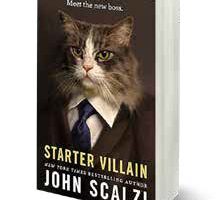ìThe creative person should have no other biography than his works.î ñ B. TravenThe myth of King Midas, repeated over the ages, reminds us there are more important things in life than gold. Certainly, as B. Traven shows us in ìThe Treasure of the Sierra Madre,î itís nothing to lose your head over. You may have seen the movie, starring Humphrey Bogart, but if you havenít read the book, youíre missing out!Written in 1935, in splendid plain-speak prose, the novel is anything but old fashioned; and its message will never go out of style. Greed, thieves, unscrupulous government officials and get-rich-quick schemes have been part of every culture since humans stood upright. Yet, Traven makes the evils appear so much more appropriate in the milieu of Mexico, as three down-and-out Americans seek their fortune in the harsh conditions of the Sierra Madre Mountains.As the story opens, Dobbs is sitting on a bench in a port town. Heís attempting to figure out where he will get his next meal. Itís not that he objects to working, but with the Great Depression raging, there are no jobs or at least none suitable for white men living in Mexico. An American tourist in a white suit pauses nearby to get a shoeshine. Dobbs approaches him, asking for a hand-out, and finds himself the beneficiary of a whole peso. A windfall! With this simple text, Traven sets the scene and mood of the story: ìWhat should he do with this treasure? One dinner and one supper? Or two dinners? Or ten packages of cigarettes Artistas? Or five cups of coffee, each with a roll, or what they called here pan francÈs?îInstead, Dobbs decides to spend a night at the Hotel Oso Negro, a flop house where for 50 centavos a night men sleep on cots in one large filthy room. There, he meets another American, Moulton, and the two decide to try their luck in the oil fields of Tuxpam. In this section of the novel it becomes apparent Traven knows his stuff. He reveals the impact oil drilling had on the Mexican landscape. You cannot only visualize the pollution ñ you will taste the acidic fumes and sense the sweat sticking to your shirt. Readers also learn about the indigenous population, which suffered from disease and enslavement ever since Cortez set foot on their shores.Finding no work, Dobbs returns to the Port. Once again finding himself at the Hotel Oso Negro, he becomes enthralled with a tale being told by Howard, an elderly gold prospector. Howard speaks about gold fever as an incurable disease. ìItís easier to leave a gambling table when youíre winning than to leave a rich claim, after youíve made your good cut,î he claims. He should know, having hunted for gold in every corner of the world, from Alaska to Australia.Yet, driven by hunger, Howard is ready to try again. He is joined by Dobbs and Curtin, a crazy American who keeps mum about the indiscretions that caused him to flee the States. Setting off for the mountains, the group encounters all the hardships the desert landscape can inflict: heat, a choking thirst, stinging insects and the back-breaking drudgery of mining gold dust. Finally accumulating enough dust to feed them for a lifetime, they find themselves surrounded by a group of bandits, who claim to be Mexican police.When Curtin asks to see their badges, Traven delivers the most famous lines in the book, reworded for the movie. ìBadges … I donít have to show you any stinking badges, you god-damned cabrÛn and chingí tu madre!î (I wonít translate that for you because the NFH is a family paper.)After ìThe Treasure of the Sierra Madreî hit the big screen, people wanted to know more about the author. Some believe he was Otto Feige, an anarchist who fled Germany at the turn of the 20th century. But Traven refused to answer any questions about his identity. When John Houston asked Traven to consult on the movie version of his novel, he declined, saying he would send his agent, Hal Croves, in his stead. Photographic evidence later revealed that Croves and Traven were indeed one and the same person. Clearly, this man had a secret worth hiding.His ìLast Will and Testamentî claims he was actually born in Chicago, but few of the journalists who attempted to reveal his identity believe that. Personally, Iím not so sure. His prose reads like John Steinbeckís, and his intimate knowledge of both U.S. and Mexican cultures seem as if he must be one of us.Hereís what can be said for certain. He wrote under the pen names of Ret Marut and B. Traven. Albert Einstein was one of his biggest fans. The man understood the ins and outs of oil and gold exploration. And he created a masterpiece, incorporating a harsh landscape with the darkest side of human nature. Furthermore, his quote about what a writer should be remembered by is oh so true!This golden oldie stands the test of time. Read ìThe Treasure of the Sierra Madre.î






